Polish language
Polish (język polski, [ˈjɛ̃zɨk ˈpɔlskʲi] (![]()
![]()
![]()
| Polish | |
|---|---|
| polski | |
| Pronunciation | [ˈpɔlskʲi] ( |
| Native to | Poland, Germany, Czech Republic, Slovakia, Hungary, Lithuania, parts of Latvia, bordering Kresy regions of Western Ukraine and Western Belarus |
| Ethnicity | Poles Kashubs Silesians |
Native speakers | 45 million[1] L2 speakers: 5 million+[2] |
Early forms | |
| Latin (Polish alphabet) Polish Braille | |
| System Językowo-Migowy (SJM) | |
| Official status | |
Official language in | |
Recognised minority language in | |
| Regulated by | Polish Language Council (of the Polish Academy of Sciences) |
| Language codes | |
| ISO 639-1 | pl |
| ISO 639-2 | pol |
| ISO 639-3 | pol – inclusive codeIndividual code: szl – Silesian |
| Glottolog | poli1260[8] |
| Linguasphere | 53-AAA-cc 53-AAA-b..-d |
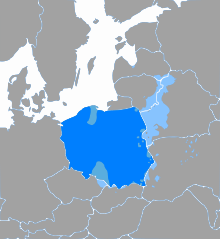 Majority of Polish speakers
Polish used together alongside other languages
Minority of Polish speakers | |
Polish is written with the standardized Polish alphabet, which has nine additions to the letters of the basic Latin script (ą, ć, ę, ł, ń, ó, ś, ź, ż). Among the major languages, it is most closely related to Slovak[10] and Czech,[11] but differs from other Slavic varieties in terms of pronunciation and general grammar. In addition, Polish was profoundly influenced by Latin and other Italic languages like Italian and French as well as Germanic languages (most notably German), which contributed to a large number of loanwords and similar grammatical structures.[12][13][14] Polish currently has the largest number of speakers of the West Slavic group and is also the second most widely spoken Slavic language behind Russian.[15][16]
Historically, Polish was a lingua franca,[17][18] important both diplomatically and academically in Central and Eastern Europe. Today, Polish is spoken by over 38.5 million people as their first language in Poland. It is also spoken as a second language in Northern Czech Republic and Slovakia, western parts of Belarus and Ukraine as well as in Central-Eastern Lithuania and Latvia. Because of the emigration from Poland during different time periods, most notably after World War II, millions of Polish speakers can be found in countries such as Canada, Argentina, Brazil, Israel, Australia, the United Kingdom and the United States.
History
Polish began to emerge as a distinct language around the 10th century, the process largely triggered by the establishment and development of the Polish state. Mieszko I, ruler of the Polans tribe from the Greater Poland region, united a few culturally and linguistically related tribes from the basins of the Vistula and Oder before eventually accepting baptism in 966. With Christianity, Poland also adopted the Latin alphabet, which made it possible to write down Polish, which until then had existed only as a spoken language.[19]
The precursor to modern Polish is the Old Polish language. Ultimately, Polish is thought to descend from the unattested Proto-Slavic language. Polish was a lingua franca from 1500–1700 in Central and parts of Eastern Europe, because of the political, cultural, scientific and military influence of the former Polish–Lithuanian Commonwealth.[20] Although not closely related to it, Polish shares many linguistic affinities with Ukrainian, an East Slavic language with which it has been in prolonged historical contact and in a state of mutual influence.[11][21][22] The Polish influence on Ukrainian is particularly marked in western Ukraine, which was under Polish cultural domination.[23]
The Book of Henryków (Polish: Księga henrykowska, Latin: Liber fundationis claustri Sanctae Mariae Virginis in Heinrichau), contains the earliest known sentence written in the Polish language: Day, ut ia pobrusa, a ti poziwai (in modern orthography: Daj, uć ja pobrusza, a ti pocziwaj; the corresponding sentence in modern Polish: Daj, niech ja pomielę, a ty odpoczywaj or Pozwól, że ja będę mełł, a ty odpocznij; and in English: Come, let me grind, and you take a rest), written around 1270.
The medieval recorder of this phrase, the Cistercian monk Peter of the Henryków monastery, noted that "Hoc est in polonico" ("This is in Polish").[24][25][26]
Polish, along with Czech and Slovak, forms the West Slavic dialect continuum. The three languages constitute Ausbau languages, i.e. lects that are considered distinct not on purely linguistic grounds, but rather due to sociopolitical and cultural factors.[27] Since the idioms have separately standardized norms and longstanding literary traditions, being the official languages of independent states, they are generally treated as autonomous languages, with the distinction between Polish and Czech-Slovak dialects being drawn along national lines.[27]
Geographic distribution
Poland is one of the most linguistically homogeneous European countries; nearly 97% of Poland's citizens declare Polish as their first language. Elsewhere, Poles constitute large minorities in Lithuania, Belarus, and Ukraine. Polish is the most widely used minority language in Lithuania's Vilnius County (26% of the population, according to the 2001 census results, with Vilnius having been part of Poland from 1922 until 1939) and is found elsewhere in southeastern Lithuania. In Ukraine, it is most common in western Lviv and Volyn Oblasts, while in West Belarus it is used by the significant Polish minority, especially in the Brest and Grodno regions and in areas along the Lithuanian border. There are significant numbers of Polish speakers among Polish emigrants and their descendants in many other countries.
In the United States, Polish Americans number more than 11 million but most of them cannot speak Polish fluently. According to the 2000 United States Census, 667,414 Americans of age five years and over reported Polish as the language spoken at home, which is about 1.4% of people who speak languages other than English, 0.25% of the US population, and 6% of the Polish-American population. The largest concentrations of Polish speakers reported in the census (over 50%) were found in three states: Illinois (185,749), New York (111,740), and New Jersey (74,663).[28] Enough people in these areas speak Polish that PNC Financial Services (which has a large number of branches in all of these areas) offer services available in Polish at all of their cash machines in addition to English and Spanish.[29]
According to the 2011 census there are now over 500,000 people in England and Wales who consider Polish to be their "main" language. In Canada, there is a significant Polish Canadian population: There are 242,885 speakers of Polish according to the 2006 census, with a particular concentration in Toronto (91,810 speakers) and Montreal.[30]
The geographical distribution of the Polish language was greatly affected by the territorial changes of Poland immediately after World War II and Polish population transfers (1944–46). Poles settled in the "Recovered Territories" in the west and north, which had previously been mostly German-speaking. Some Poles remained in the previously Polish-ruled territories in the east that were annexed by the USSR, resulting in the present-day Polish-speaking minorities in Lithuania, Belarus, and Ukraine, although many Poles were expelled or emigrated from those areas to areas within Poland's new borders. To the east of Poland, the most significant Polish minority lives in a long, narrow strip along either side of the Lithuania-Belarus border. Meanwhile, the flight and expulsion of Germans (1944–50), as well as the expulsion of Ukrainians and Operation Vistula, the 1947 forced resettlement of Ukrainian minorities to the Recovered Territories in the west of the country, contributed to the country's linguistic homogeneity.
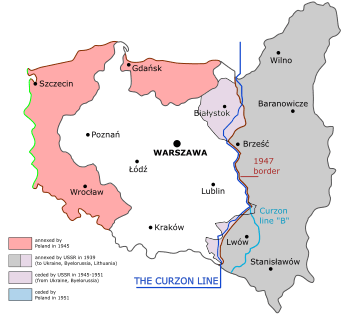
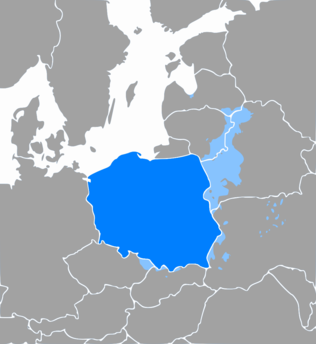
Dialects

The Polish language became far more homogeneous in the second half of the 20th century, in part due to the mass migration of several million Polish citizens from the eastern to the western part of the country after the Soviet annexation of the Kresy (Eastern Borderlands) in 1939, and the annexation of former German territory after World War II. This tendency toward homogeneity also stems from the vertically integrated nature of the Polish People's Republic.[31] In addition, Polish linguistics has been characterized by a strong strive towards promoting prescriptive ideas of language intervention and usage uniformity,[32] along with normatively-oriented notions of language "correctness"[33] (unusual by Western standards).[32]
The inhabitants of different regions of Poland still speak Polish somewhat differently, although the differences between modern-day vernacular varieties and standard Polish (język ogólnopolski) appear relatively slight. Most of the middle aged and young speak vernaculars close to standard Polish, while the traditional dialects are preserved among older people in rural areas.[33] First-language speakers of Polish have no trouble understanding each other, and non-native speakers may have difficulty recognizing the regional and social differences. The modern standard dialect, often termed as "correct Polish",[33] is spoken or at least understood throughout the entire country.[11]
Polish has traditionally been described as consisting of four or five main regional dialects:
- Greater Polish, spoken in the west
- Lesser Polish, spoken in the south and southeast
- Masovian, spoken throughout the central and eastern parts of the country
- Silesian, spoken in the southwest (also considered a separate language, see comment below)
Kashubian, spoken in Pomerania west of Gdańsk on the Baltic Sea, is thought of either as a fifth Polish dialect or a distinct language, depending on the criteria used.[34][35] It contains a number of features not found elsewhere in Poland, e.g. nine distinct oral vowels (vs. the five of standard Polish) and (in the northern dialects) phonemic word stress, an archaic feature preserved from Common Slavic times and not found anywhere else among the West Slavic languages. However, it "lacks most of the linguistic and social determinants of language-hood".[36]
Many linguistic sources about the Slavic languages describe Silesian as a dialect of Polish.[37][38] However, many Silesians consider themselves a separate ethnicity and have been advocating for the recognition of a Silesian language. According to the last official census in Poland in 2011, over half a million people declared Silesian as their native language. Many sociolinguists (e.g. Tomasz Kamusella,[39] Agnieszka Pianka, Alfred F. Majewicz,[40] Tomasz Wicherkiewicz)[41] assume that extralinguistic criteria decide whether a lect is an independent language or a dialect: speakers of the speech variety or/and political decisions, and this is dynamic (i.e. it changes over time). Also, research organizations such as SIL International[42] and resources for the academic field of linguistics such as Ethnologue,[43] Linguist List[44] and others, for example the Ministry of Administration and Digitization[45] recognized the Silesian language. In July 2007, the Silesian language was recognized by ISO, and was attributed an ISO code of szl.
Some additional characteristic but less widespread regional dialects include:
- The distinctive dialect of the Gorals (Góralski) occurs in the mountainous area bordering the Czech Republic and Slovakia. The Gorals ("Highlanders") take great pride in their culture and the dialect. It exhibits some cultural influences from the Vlach shepherds who migrated from Wallachia (southern Romania) in the 14th–17th centuries.[46]
- The Poznanski dialect, spoken in Poznań and to some extent in the whole region of the former Prussian Partition (excluding Upper Silesia), with noticeable German influences.
- In the northern and western (formerly German) regions where Poles from the territories annexed by the Soviet Union resettled after World War II, the older generation speaks a dialect of Polish characteristic of the Kresy that includes a longer pronunciation of vowels.
- Poles living in Lithuania (particularly in the Vilnius region), in Belarus (particularly the northwest), and in the northeast of Poland continue to speak the Eastern Borderlands dialect, which sounds "slushed" (in Polish described as zaciąganie z ruska, "speaking with a Ruthenian drawl") and is easily distinguishable.
- Some city dwellers, especially the less affluent population, had their own distinctive dialects - for example, the Warsaw dialect, still spoken by some of the population of Praga on the eastern bank of the Vistula. (Praga remained the only part of Warsaw where the population survived World War II relatively intact.) However, these city dialects are now mostly extinct due to assimilation with standard Polish.
- Many Poles living in emigrant communities (for example, in the USA), whose families left Poland just after World War II, retain a number of minor features of Polish vocabulary as spoken in the first half of the 20th century that now sound archaic to contemporary visitors from Poland.
Phonology
Vowels and consonants
Polish has six oral vowels (all monophthongs) and two nasal vowels. The oral vowels are /i/ (spelled i), /ɨ/ (spelled y), /ɛ/ (spelled e), /a/ (spelled a), /ɔ/ (spelled o) and /u/ (spelled u or ó). The nasal vowels are /ɛ̃/ (spelled ę) and /ɔ̃/ (spelled ą).
The Polish consonant system shows more complexity: its characteristic features include the series of affricate and palatal consonants that resulted from four Proto-Slavic palatalizations and two further palatalizations that took place in Polish and Belarusian. The full set of consonants, together with their most common spellings, can be presented as follows (although other phonological analyses exist):
- stops /p/ (p), /b/ (b), /t/ (t), /d/ (d), /k/ (k), /ɡ/ (g), and the palatalized forms /pʲ/ (pi), /bʲ/ (bi), /kʲ/ (ki) and /ɡʲ/ (gi)
- fricatives /f/ (f), /v/ (w), /fʲ/ (fi), /vʲ/ (wi), /s/ (s), /z/ (z), /ʂ/ (sz), /ʐ/ (ż, rz), the alveolo-palatals /ɕ/ (ś, si) and /ʑ/ (ź, zi), and /x/ (ch, h) and /xʲ/ (chi, hi)
- affricates /ts/ (c), /dz/ (dz), /tʂ/ (cz), /dʐ/ (dż), /tɕ/ (ć, ci), /dʑ/ (dź, dzi) (these are written here without ties for browser display compatibility, although Polish does distinguish between affricates as in czy, and stop–fricative clusters as in trzy)
- nasals /m/ (m), /n/ (n), /ɲ/ (ń, ni)
- approximants /l/ (l), /j/ (j), /w/ (ł)
- trill /r/
.svg.png)
Neutralization occurs between voiced–voiceless consonant pairs in certain environments: at the end of words (where devoicing occurs), and in certain consonant clusters (where assimilation occurs). For details, see Voicing and devoicing in the article on Polish phonology.
Most Polish words are paroxytones (that is, the stress falls on the second-to-last syllable of a polysyllabic word), although there are exceptions.
Consonant distribution
Polish permits complex consonant clusters, which historically often arose from the disappearance of yers. Polish can have word-initial and word-medial clusters of up to four consonants, whereas word-final clusters can have up to five consonants.[47] Examples of such clusters can be found in words such as bezwzględny [bɛzˈvzɡlɛndnɨ] ('absolute' or 'heartless', 'ruthless'), źdźbło [ˈʑd͡ʑbwɔ] ('blade of grass'), ![]()
![]()
Unlike languages such as Czech, Polish does not have syllabic consonants – the nucleus of a syllable is always a vowel.[48]
The consonant /j/ is restricted to positions adjacent to a vowel. It also cannot precede i or y.
Prosody
The predominant stress pattern in Polish is penultimate stress – in a word of more than one syllable, the next-to-last syllable is stressed. Alternating preceding syllables carry secondary stress, e.g. in a four-syllable word, where the primary stress is on the third syllable, there will be secondary stress on the first.[49]
Each vowel represents one syllable, although the letter i normally does not represent a vowel when it precedes another vowel (it represents /j/, palatalization of the preceding consonant, or both depending on analysis). Also the letters u and i sometimes represent only semivowels when they follow another vowel, as in autor /ˈawtɔr/ ('author'), mostly in loanwords (so not in native nauka /naˈu.ka/ 'science, the act of learning', for example, nor in nativized Mateusz /maˈte.uʂ/ 'Matthew').
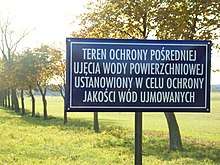
Some loanwords, particularly from the classical languages, have the stress on the antepenultimate (third-from-last) syllable. For example, fizyka (/ˈfizɨka/) ('physics') is stressed on the first syllable. This may lead to a rare phenomenon of minimal pairs differing only in stress placement, for example muzyka /ˈmuzɨka/ 'music' vs. muzyka /muˈzɨka/ - genitive singular of muzyk 'musician'. When additional syllables are added to such words through inflection or suffixation, the stress normally becomes regular. For example, uniwersytet (/uɲiˈvɛrsɨtɛt/, 'university') has irregular stress on the third (or antepenultimate) syllable, but the genitive uniwersytetu (/uɲivɛrsɨˈtɛtu/) and derived adjective uniwersytecki (/uɲivɛrsɨˈtɛt͡skʲi/) have regular stress on the penultimate syllables. Over time, loanwords become nativized to have penultimate stress.[50]
Another class of exceptions is verbs with the conditional endings -by, -bym, -byśmy, etc. These endings are not counted in determining the position of the stress; for example, zrobiłbym ('I would do') is stressed on the first syllable, and zrobilibyśmy ('we would do') on the second. According to prescriptive authorities, the same applies to the first and second person plural past tense endings -śmy, -ście, although this rule is often ignored in colloquial speech (so zrobiliśmy 'we did' should be prescriptively stressed on the second syllable, although in practice it is commonly stressed on the third as zrobiliśmy).[51] These irregular stress patterns are explained by the fact that these endings are detachable clitics rather than true verbal inflections: for example, instead of kogo zobaczyliście? ('whom did you see?') it is possible to say kogoście zobaczyli? – here kogo retains its usual stress (first syllable) in spite of the attachment of the clitic. Reanalysis of the endings as inflections when attached to verbs causes the different colloquial stress patterns. These stress patterns are however nowadays sanctioned as part of the colloquial norm of standard Polish.[52]
Some common word combinations are stressed as if they were a single word. This applies in particular to many combinations of preposition plus a personal pronoun, such as do niej ('to her'), na nas ('on us'), przeze mnie ('because of me'), all stressed on the bolded syllable.
Orthography
The Polish alphabet derives from the Latin script, but includes certain additional letters formed using diacritics. The Polish alphabet was one of three major forms of Latin-based orthography developed for Slavic languages, the others being Czech orthography and Croatian orthography, the last of these being a 19th-century invention trying to make a compromise between the first two. Kashubian uses a Polish-based system, Slovak uses a Czech-based system, and Slovene follows the Croatian one; the Sorbian languages blend the Polish and the Czech ones.
The diacritics used in the Polish alphabet are the kreska (graphically similar to the acute accent) in the letters ć, ń, ó, ś, ź and through the letter in ł; the kropka (superior dot) in the letter ż, and the ogonek ("little tail") in the letters ą, ę. The letters q, v, x are used only in foreign words and names.[53]
Polish orthography is largely phonemic—there is a consistent correspondence between letters (or digraphs and trigraphs) and phonemes (for exceptions see below). The letters of the alphabet and their normal phonemic values are listed in the following table.
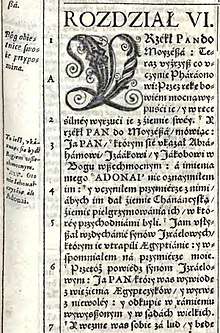
| Upper case |
Lower case |
Phonemic value(s) |
Upper case |
Lower case |
Phonemic value(s) |
|---|---|---|---|---|---|
| A | a | /a/ | Ń | ń | /ɲ/ |
| Ą | ą | /ɔ̃/, /ɔn/, /ɔm/ | O | o | /ɔ/ |
| B | b | /b/ (/p/) | Ó | ó | /u/ |
| C | c | /ts/ | P | p | /p/ |
| Ć | ć | /tɕ/ | Q | q | Only loanwords |
| D | d | /d/ (/t/) | R | r | /r/ |
| E | e | /ɛ/ | S | s | /s/ |
| Ę | ę | /ɛ̃/, /ɛn/, /ɛm/, /ɛ/ | Ś | ś | /ɕ/ |
| F | f | /f/ | T | t | /t/ |
| G | g | /ɡ/ (/k/) | U | u | /u/ |
| H | h | /ɣ/ (/x/) | V | v | Only loanwords |
| I | i | /i/, /j/ | W | w | /v/ (/f/) |
| J | j | /j/ | X | x | Only loanwords |
| K | k | /k/ | Y | y | /ɨ/, /ɘ/ |
| L | l | /l/ | Z | z | /z/ (/s/) |
| Ł | ł | /w/, /ɫ/ | Ź | ź | /ʑ/ (/ɕ/) |
| M | m | /m/ | Ż | ż | /ʐ/ (/ʂ/) |
| N | n | /n/ |
The following digraphs and trigraphs are used:
| Digraph | Phonemic value(s) | Digraph/trigraph (before a vowel) |
Phonemic value(s) |
|---|---|---|---|
| ch | /x/ | ci | /tɕ/ |
| cz | /tʂ/ | dzi | /dʑ/ |
| dz | /dz/ (/ts/) | gi | /ɡʲ/ |
| dź | /dʑ/ (/tɕ/) | (c)hi | /xʲ/ |
| dż | /dʐ/ (/tʂ/) | ki | /kʲ/ |
| rz | /ʐ/ (/ʂ/) | ni | /ɲ/ |
| sz | /ʂ/ | si | /ɕ/ |
| zi | /ʑ/ |
Voiced consonant letters frequently come to represent voiceless sounds (as shown in the tables); this occurs at the end of words and in certain clusters, due to the neutralization mentioned in the Phonology section above. Occasionally also voiceless consonant letters can represent voiced sounds in clusters.
The spelling rule for the palatal sounds /ɕ/, /ʑ/, /tɕ/, /dʑ/ and /ɲ/ is as follows: before the vowel i the plain letters s, z, c, dz, n are used; before other vowels the combinations si, zi, ci, dzi, ni are used; when not followed by a vowel the diacritic forms ś, ź, ć, dź, ń are used. For example, the s in siwy ("grey-haired"), the si in siarka ("sulphur") and the ś in święty ("holy") all represent the sound /ɕ/. The exceptions to the above rule are certain loanwords from Latin, Italian, French, Russian or English—where s before i is pronounced as s, e.g. sinus, sinologia, do re mi fa sol la si do, Saint-Simon i saint-simoniści, Sierioża, Siergiej, Singapur, singiel. In other loanwords the vowel i is changed to y, e.g. Syria, Sybir, synchronizacja, Syrakuzy.
The following table shows the correspondence between the sounds and spelling:
Digraphs and trigraphs are used:
| Phonemic value | Single letter/Digraph (in pausa or before a consonant) |
Digraph/Trigraph (before a vowel) |
Single letter/Digraph (before the vowel i) |
|---|---|---|---|
| /tɕ/ | ć | ci | c |
| /dʑ/ | dź | dzi | dz |
| /ɕ/ | ś | si | s |
| /ʑ/ | ź | zi | z |
| /ɲ/ | ń | ni | n |
Similar principles apply to /kʲ/, /ɡʲ/, /xʲ/ and /lʲ/, except that these can only occur before vowels, so the spellings are k, g, (c)h, l before i, and ki, gi, (c)hi, li otherwise. Most Polish speakers, however, do not consider palatalisation of k, g, (c)h or l as creating new sounds.
Except in the cases mentioned above, the letter i if followed by another vowel in the same word usually represents /j/, yet a palatalisation of the previous consonant is always assumed.
The letters ą and ę, when followed by plosives and affricates, represent an oral vowel followed by a nasal consonant, rather than a nasal vowel. For example, ą in dąb ("oak") is pronounced /ɔm/, and ę in tęcza ("rainbow") is pronounced /ɛn/ (the nasal assimilates to the following consonant). When followed by l or ł (for example przyjęli, przyjęły), ę is pronounced as just e. When ę is at the end of the word it is often pronounced as just /ɛ/.
Note that, depending on the word, the phoneme /x/ can be spelt h or ch, the phoneme /ʐ/ can be spelt ż or rz, and /u/ can be spelt u or ó. In several cases it determines the meaning, for example: może ("maybe") and morze ("sea").
In occasional words, letters that normally form a digraph are pronounced separately. For example, rz represents /rz/, not /ʐ/, in words like zamarzać ("freeze") and in the name Tarzan.
Notice that doubled letters represent separate occurrences of the sound in question; for example Anna is pronounced /anːa/ in Polish (the double n is often pronounced as a lengthened single n).
There are certain clusters where a written consonant would not be pronounced. For example, the ł in the words mógł ("could") and jabłko ("apple") might be omitted in ordinary speech, leading to the pronunciations muk and japko or jabko.
Grammar
Polish is a highly fusional language with relatively free word order, although the dominant arrangement is subject–verb–object (SVO). There are no articles, and subject pronouns are often dropped.
Nouns belong to one of three genders: masculine, feminine and neuter. A distinction is also made between animate and inanimate masculine nouns in the singular, and between masculine personal and non-masculine-personal nouns in the plural. There are seven cases: nominative, genitive, dative, accusative, instrumental, locative and vocative.
Adjectives agree with nouns in terms of gender, case, and number. Attributive adjectives most commonly precede the noun, although in certain cases, especially in fixed phrases (like język polski, "Polish (language)"), the noun may come first; the rule of thumb is that generic descriptive adjective normally precedes (e.g. piękny kwiat, “beautiful flower”) while categorising adjective often follows the noun (e.g. węgiel kamienny, “black coal”). Most short adjectives and their derived adverbs form comparatives and superlatives by inflection (the superlative is formed by prefixing naj- to the comparative).
Verbs are of imperfective or perfective aspect, often occurring in pairs. Imperfective verbs have a present tense, past tense, compound future tense (except for być "to be", which has a simple future będę etc., this in turn being used to form the compound future of other verbs), subjunctive/conditional (formed with the detachable particle by), imperatives, an infinitive, present participle, present gerund and past participle. Perfective verbs have a simple future tense (formed like the present tense of imperfective verbs), past tense, subjunctive/conditional, imperatives, infinitive, present gerund and past participle. Conjugated verb forms agree with their subject in terms of person, number, and (in the case of past tense and subjunctive/conditional forms) gender.
Passive-type constructions can be made using the auxiliary być or zostać ("become") with the passive participle. There is also an impersonal construction where the active verb is used (in third person singular) with no subject, but with the reflexive pronoun się present to indicate a general, unspecified subject (as in pije się wódkę "vodka is being drunk"—note that wódka appears in the accusative). A similar sentence type in the past tense uses the passive participle with the ending -o, as in widziano ludzi ("people were seen"). As in other Slavic languages, there are also subjectless sentences formed using such words as można ("it is possible") together with an infinitive.
Yes-no questions (both direct and indirect) are formed by placing the word czy at the start. Negation uses the word nie, before the verb or other item being negated; nie is still added before the verb even if the sentence also contains other negatives such as nigdy ("never") or nic ("nothing"), effectively creating a double negative.
Cardinal numbers have a complex system of inflection and agreement. Zero and cardinal numbers higher than five (except for those ending with the digit 2, 3 or 4 but not ending with 12, 13 or 14) govern the genitive case rather than the nominative or accusative. Special forms of numbers (collective numerals) are used with certain classes of noun, which include dziecko ("child") and exclusively plural nouns such as drzwi ("door").
Borrowed words
Polish has, over the centuries, borrowed a number of words from other languages. When borrowing, pronunciation was adapted to Polish phonemes and spelling was altered to match Polish orthography. In addition, word endings are liberally applied to almost any word to produce verbs, nouns, adjectives, as well as adding the appropriate endings for cases of nouns, adjectives, diminutives, double-diminutives, augmentatives, etc.
Depending on the historical period, borrowing has proceeded from various languages. Notable influences have been Latin (10th–18th centuries),[21] Czech (10th and 14th–15th centuries), Italian (16th–17th centuries),[21] French (17th–19th centuries),[21] German (13–15th and 18th–20th centuries), Hungarian (15th–16th centuries)[21] and Turkish (17th century). Currently, English words are the most common imports to Polish.[54]
The Latin language, for a very long time the only official language of the Polish state, has had a great influence on Polish. Many Polish words were direct borrowings or calques (e.g. rzeczpospolita from res publica) from Latin. Latin was known to a larger or smaller degree by most of the numerous szlachta in the 16th to 18th centuries (and it continued to be extensively taught at secondary schools until World War II). Apart from dozens of loanwords, its influence can also be seen in a number of verbatim Latin phrases in Polish literature (especially from the 19th century and earlier).
During the 12th and 13th centuries, Mongolian words were brought to the Polish language during wars with the armies of Genghis Khan and his descendants, e.g. dzida (spear) and szereg (a line or row).[54]
Words from Czech, an important influence during the 10th and 14th–15th centuries include sejm, hańba and brama.[54]
In 1518, the Polish king Sigismund I the Old married Bona Sforza, the niece of the Holy Roman emperor Maximilian, who introduced Italian cuisine to Poland, especially vegetables.[55] Hence, words from Italian include pomidor from "pomodoro" (tomato), kalafior from "cavolfiore" (cauliflower), and pomarańcza, a portmanteau from Italian "pomo" (pome) plus "arancio" (orange). A later word of Italian origin is autostrada (from Italian "autostrada", highway).[55]
In the 18th century, with the rising prominence of France in Europe, French supplanted Latin as an important source of words. Some French borrowings also date from the Napoleonic era, when the Poles were enthusiastic supporters of Napoleon. Examples include ekran (from French "écran", screen), abażur ("abat-jour", lamp shade), rekin ("requin", shark), meble ("meuble", furniture), bagaż ("bagage", luggage), walizka ("valise", suitcase), fotel ("fauteuil", armchair), plaża ("plage", beach) and koszmar ("cauchemar", nightmare). Some place names have also been adapted from French, such as the Warsaw borough of Żoliborz ("joli bord" = beautiful riverside), as well as the town of Żyrardów (from the name Girard, with the Polish suffix -ów attached to refer to the founder of the town).[56]

Many words were borrowed from the German language from the sizable German population in Polish cities during medieval times. German words found in the Polish language are often connected with trade, the building industry, civic rights and city life. Some words were assimilated verbatim, for example handel (trade) and dach (roof); others are pronounced the same, but differ in writing schnur—sznur (cord). As a result of being neighbours with Germany, Polish has many German expressions which have become literally translated (calques). The regional dialects of Upper Silesia and Masuria (Modern Polish East Prussia) have noticeably more German loanwords than other varieties.
The contacts with Ottoman Turkey in the 17th century brought many new words, some of them still in use, such as: jar ("yar" deep valley), szaszłyk ("şişlik" shish kebab), filiżanka ("fincan" cup), arbuz ("karpuz" watermelon), dywan ("divan" carpet),[57] etc.
From the founding of the Kingdom of Poland in 1025 through the early years of the Polish–Lithuanian Commonwealth created in 1569, Poland was the most tolerant country of Jews in Europe. Known as the "paradise for the Jews",[58][59] it became a shelter for persecuted and expelled European Jewish communities and the home to the world's largest Jewish community of the time. As a result, many Polish words come from Yiddish, spoken by the large Polish Jewish population that existed until the Holocaust. Borrowed Yiddish words include bachor (an unruly boy or child), bajzel (slang for mess), belfer (slang for teacher), ciuchy (slang for clothing), cymes (slang for very tasty food), geszeft (slang for business), kitel (slang for apron), machlojka (slang for scam), mamona (money), manele (slang for oddments), myszygene (slang for lunatic), pinda (slang for girl, pejoratively), plajta (slang for bankruptcy), rejwach (noise), szmal (slang for money), and trefny (dodgy).[60]
The mountain dialects of the Górale in southern Poland, have quite a number of words borrowed from Hungarian (e.g. baca, gazda, juhas, hejnał) and Romanian as a result of historical contacts with Hungarian-dominated Slovakia and Wallachian herders who travelled north along the Carpathians.[61]
Thieves' slang includes such words as kimać (to sleep) or majcher (knife) of Greek origin, considered then unknown to the outside world.[62]
In addition, Turkish and Tatar have exerted influence upon the vocabulary of war, names of oriental costumes etc.[21] Russian borrowings began to make their way into Polish from the second half of the 19th century on.[21]
Polish has also received an intensive number of English loanwords, particularly after World War II.[21] Recent loanwords come primarily from the English language, mainly those that have Latin or Greek roots, for example komputer (computer), korupcja (from 'corruption', but sense restricted to 'bribery') etc. Concatenation of parts of words (e.g. auto-moto), which is not native to Polish but common in English, for example, is also sometimes used. When borrowing English words, Polish often changes their spelling. For example, Latin suffix '-tio' corresponds to -cja. To make the word plural, -cja becomes -cje. Examples of this include inauguracja (inauguration), dewastacja (devastation), recepcja (reception), konurbacja (conurbation) and konotacje (connotations). Also, the digraph qu becomes kw (kwadrant = quadrant; kworum = quorum).
Loanwords from Polish

The Polish language has influenced others. Particular influences appear in other Slavic languages and in German — due to their proximity and shared borders.[63] Examples of loanwords include German Grenze (border),[64] Dutch and Afrikaans grens from Polish granica; German Peitzker from Polish piskorz (weatherfish); German Zobel, French zibeline, Swedish sobel, and English sable from Polish soból; and ogonek ("little tail") — the word describing a diacritic hook-sign added below some letters in various alphabets. "Szmata," a Polish, Slovak and Ruthenian word for "mop" or "rag", became part of Yiddish. The Polish language exerted significant lexical influence upon Ukrainian, particularly in the fields of abstract and technical terminology; for example, the Ukrainian word панство panstvo (country) is derived from Polish państwo.[23] The extent of Polish influence is particularly noticeable in Western Ukrainian dialects.[23]
There is a substantial number of Polish words which officially became part of Yiddish, once the main language of European Jews. These include basic items, objects or terms such as a bread bun (Polish bułka, Yiddish בולקע bulke), a fishing rod (wędka, ווענטקע ventke), an oak (dąb, דעמב demb), a meadow (łąka, לאָנקע lonke), a moustache (wąsy, וואָנצעס vontses) and a bladder (pęcherz, פּענכער penkher).[65]
Quite a few culinary loanwords exist in German and in other languages, some of which describe distinctive features of Polish cuisine. These include German and English Quark from twaróg (a kind of fresh cheese) and German Gurke, English gherkin from ogórek (cucumber). The word pierogi (Polish dumplings) has spread internationally, as well as pączki (Polish donuts)[66] and kiełbasa (sausage, e.g. kolbaso in Esperanto). As far as pierogi concerned, the original Polish word is already in plural (sing. pieróg, plural pierogi; stem pierog-, plural ending -i; NB. o becomes ó in a closed syllable, like here in singular), yet it is commonly used with the English plural ending -s in Canada and United States of America, pierogis, thus making it a "double plural". A similar situation happened with the Polish loanword from English czipsy ("potato chips")—from English chips being already plural in the original (chip + -s), yet it has obtained the Polish plural ending -y.
The word spruce entered the English language from the Polish name of Prusy (a historical region, today part of Poland). It became spruce because in Polish, z Prus, sounded like "spruce" in English (transl. "from Prussia") and was a generic term for commodities brought to England by Hanseatic merchants and because the tree was believed to have come from Polish Ducal Prussia.[67] However, it can be argued that the word is actually derived from the Old French term Pruce, meaning literally Prussia.[68]
See also
References
- World Almanac and Book of Facts, World Almanac Books, Mahwah, 1999. ISBN 0-88687-832-2.
- Encyklopedia języka polskiego, pod red. S Urbańczyka i M. Kucały, Ossolineum, wyd. 3, Warszawa 1999, ISBN 83-04-02994-4, s. 156.
- European Charter for Regional or Minority Languages
- "Nyelvi sokszínűség az EU-ban – hivatalos regionális és kisebbségi nyelvek a tagállamokban" (in Hungarian). 16 March 2016. Retrieved 28 November 2018.
- "Framework Convention for the Protection of National Minorities". Treaty No. 157 of 1 February 1995. Council of Europe. Retrieved 28 November 2018.
- "MINELRES - Minority related national legislation - Lithuania". www.minelres.lv. Retrieved 28 November 2018.
- "Law of Ukraine "On Principles of State Language Policy" (Current version — Revision from 01.02.2014)". Document 5029-17, Article 7: Regional or minority languages Ukraine, Paragraph 2. Zakon2.rada.gov.ua. 1 February 2014. Retrieved 30 April 2014.
- Hammarström, Harald; Forkel, Robert; Haspelmath, Martin, eds. (2017). "Polish". Glottolog 3.0. Jena, Germany: Max Planck Institute for the Science of Human History.
- "Lekhitic languages". Encyclopædia Britannica. 2015-01-08. Retrieved 2015-03-31.
- Stroińska, Magda; Andrews, Ernest (2018). "The Polish Language Act: Legislating a Complicated Linguistic-Political Landscape". In Andrews, Ernest (ed.). Language planning in the post-communist era: the struggles for language control in the new order in Eastern Europe, Eurasia and China. Cham: Palgrave Macmillan. p. 243. ISBN 978-3-319-70926-0. OCLC 1022080518.
- Swan, Oscar E. (2002). A grammar of contemporary Polish. Bloomington, Ind.: Slavica. p. 5. ISBN 0-89357-296-9. OCLC 50064627.
- "Język polski". Towarzystwo Miłośników Języka Polskiego. July 27, 2000 – via Google Books.
- Mańczak-Wohlfeld, Elżbieta (July 27, 1995). Tendencje rozwojowe współczesnych zapożyczeń angielskich w języku polskim. Universitas. ISBN 978-83-7052-347-3 – via Google Books.
- "Rok ... pod względem oświaty, przemysłu i wypadków czasowych". Nakł. N. Kamieńskiego i Spólki. July 27, 1844 – via Google Books.
- Ager, Simon (2007-07-10). "The importance of Polish as a language today". Cactus Language Training. Archived from the original on September 7, 2011. Retrieved 2011-09-16.
- "Statistical Summaries". Ethnologue. Retrieved 2011-09-16.
- Marácz, László; Rosello, Mireille, eds. (1 January 2012). Multilingual Europe, Multilingual Europeans. BRILL. p. 25. ISBN 978-94-012-0803-1. Retrieved 28 November 2018 – via Google Books.
- Koyama, Satoshi (2007). "Chapter 8: The Polish–Lithuanian Commonwealth as a Political Space: Its Unity and Complexity" (PDF). In Hayashi, Tadayuki; Fukuda, Hiroshi (eds.). Regions in Central and Eastern Europe: Past and Present. Slavic Research Center, Hokkaido University. pp. 137–153. ISBN 978-4-938637-43-9.
- "Polish Language History and Facts". Today Translations. 2014-06-20. Retrieved 2015-03-31.
- Barbour, Stephen; Carmichael, Cathie (2000-12-14). Language and Nationalism in Europe. OUP Oxford. ISBN 978-0-19-158407-7.
- István Fodor, Claude Hagège (1983). Language Reform: History and Future. 1. Buske. p. 324. ISBN 978-3-87118-572-4.
- Brian D. Joseph (1999). Historical Linguistics. Ohio State University, Department of Linguistics. p. 165.
- Timothy Shopen (1987). Languages and Their Status. University of Pennsylvania Press. p. 132. ISBN 978-0-8122-1249-5.
- "FIDES Digital Library - Liber fundationis claustri Sancte Marie Virginis in Henrichow = Księga henrykowska" – via digital.fides.org.pl.
- Barbara i Adam Podgórscy: Słownik gwar śląskich. Katowice: Wydawnictwo KOS, 2008, ISBN 978-83-60528-54-9
- Bogdan Walczak: Zarys dziejów języka polskiego. Wrocław: Wydawnictwo Uniwersytetu Wrocławskiego, 1999, ISBN 83-229-1867-4
- Peter Trudgill (2004). "Glocalisation and the Ausbau sociolinguistics of modern Europe". In Anna Duszak, Urszula Okulska (ed.). Speaking from the margin: global English from a European perspective. Frankfurt: Peter Lang. pp. 35–49. ISBN 978-3-631-52663-7.
- "Table 8. Detailed List of Languages Spoken at Home for the Population 5 Years and Over : By State" (PDF). Census.gov. Retrieved 2015-03-31.
- "PNC ATM Banking". PNC. Retrieved 2017-11-02.
- "Various Languages Spoken (147), Age Groups (17A) and Sex (3) for the Population of Canada, Provinces, Territories, Census Metropolitan Areas and Census Agglomerations, 2006 Census - 20% Sample Data". Statistics Canada. Archived from the original on May 27, 2008. Retrieved September 21, 2008.
- Krasnodębski, Zdzisław (20 November 2005). "Naród niedokończony". Retrieved 28 November 2018.
- Miklós Kontra, ed. (2000). "Special issue book reviews". Multilingua. Mouton Publishers. 19 (1–2 Language contact in East–Central Europe): 193. ISSN 1613-3684.
- Witold Tulasiewicz, Anthony Adams, ed. (2005). Teaching the Mother Tongue in a Multilingual Europe. A&C Black. p. 166. ISBN 978-0-8264-7027-0.
- Polish Western Affairs. Instytut Zachodni. 1989. p. 26.
- George L. Campbell, Gareth King (2012). Compendium of the World's Languages. Routledge. ISBN 978-1-136-25846-6.
- The Slavic Languages. Cambridge University Press. 1958.
- Roland Sussex and Paul Cubberley (2006). The Slavic Languages. Cambridge University Press. P. 530.
- Robert A. Rothstein (1994). "Polish". The Slavonic Languages, edited by Bernard Comrie and Greville G. Corbett. Routledge. Pp. 754–756.
- "Silesia and Central European Nationalisms", 2007. West Lafayette, IN: Purdue University Press ISBN 978-1-55753-371-5
- ["Języki świata i ich klasyfikowanie"] (en: "Languages of the world and their classification"), Polish Scientific Publishers, Warszawa 1989
- "Ekspertyza naukowa dr Tomasza Wicherkiewicza", Language Policy and the Laboratory for Research on Minority, Adam Mickiewicz University in Poznan, 2008
- "ISO documentation of Silesian language". SIL International. Archived from the original on October 3, 2012. Retrieved 2015-03-31.
- (in English) "List of languages with ISO codes". Ethnologue. SIL International. Retrieved 2015-03-31.
- "Silesian". MultiTree: A Digital Library of Language Relationships. Archived from the original on June 2, 2013.
- "Dz.U. 2012 poz. 309: Rozporządzenie Ministra Administracji i Cyfryzacji z dnia 14 lutego 2012 r. w sprawie państwowego rejestru nazw geograficznych". Internetowy System Aktów Prawnych (in Polish). 14 February 2012. Retrieved 2015-03-31.
- Magosic, Paul Robert (2005). "The Rusyn Question". Retrieved 2008-01-30.
- "Polish". UCLA Phonetics Lab data. UCLA Phonetics Laboratory, University of California, Los Angeles. Archived from the original on 20 September 2017. Retrieved 26 April 2018.
- Rubach, Jerzy (28 November 1996). "Nonsyllabic Analysis of Voice Assimilation in Polish". Linguistic Inquiry. 27 (1): 69–110. JSTOR 4178926.
- Gussmann (2007:8), deferring to Rubach & Booij (1985) for further discussion.
- Gussmann (2007), p. 9.
- Phonetics and Phonology of lexical stress in Polish verbs, Dominika Oliver, Martine Grice, Institute of Phonetics, Saarland University, Germany
- Andrzej Markowski. "Norma wzorcowa". Konferencje i dyskusje naukowe. Rada Języka Polskiego. Retrieved 2019-01-30.
- https://sjp.pwn.pl/poradnia/haslo/Q-V-X;10937.html
- Knara, Izabela (6 October 2017). "Zapożyczenia w języku polskim". e-polish.eu (in Polish). Retrieved 28 November 2018.
- Janicki, Kamil (7 October 2014). "Czy Bona Sforza naprawdę sprowadziła do Polski kapustę i kalafior?". CiekawostkiHistoryczne.pl (in Polish). Retrieved 28 November 2018.
- "Historia Żyrardowa". www.visit.zyrardow.pl. Archived from the original on 28 November 2018. Retrieved 28 November 2018.
- "kielbasa". The American Heritage Dictionary of the English Language (fourth ed.). Houghton Mifflin Company. 2000. Archived from the original on 2008-06-30. Retrieved 2009-05-06.
- Haumann, Heiko (2002-01-01). A History of East European Jews. Central European University Press. ISBN 978-963-9241-26-8.
- "A Virtual Visit to the Museum of the History of Polish Jews". Culture.pl. Retrieved 2018-09-26.
- Martinovic, Katarzyna. "Wpływ języków żydowskich na język polski". Retrieved 28 November 2018. Cite journal requires
|journal=(help) - "Historia zapożyczeń". polskiwdwunastce.edu.pl. Retrieved 28 November 2018.
- Rak, Maciej. "Kilka uwag o socjolekcie przestępczym polszczyzny przedwojennego Lwowa, "Socjolingwistyka" XXX, 2016". Retrieved 28 November 2018. Cite journal requires
|journal=(help) - Dziubalska-Kołaczyk, Katarzyna; Walczak, Bogdan (28 November 2018). "Polish". Revue belge de philologie et d'histoire. 88 (3): 817–840. doi:10.3406/rbph.2010.7805.
- "Polish Language". RealPoland. Archived from the original on 2019-04-24. Retrieved 2018-11-28.
- Gliński, Mikołaj (7 December 2015). "How Much Polish Is There in Yiddish (and How Much Yiddish Is There in Polish)?". Culture.pl. Retrieved 28 November 2018.
- Peterson, Lucas (27 February 2017). "What Are Paczki and Why Is Everyone Freaking Out About Them?". Eater. Retrieved 28 November 2018.
- "Online Etymology Dictionary". Etymonline.com. Retrieved 2015-03-31.
- "spruce - Origin and meaning of spruce by Online Etymology Dictionary". www.etymonline.com. Retrieved 28 November 2018.
Further reading
- Bisko, Wacław (1966). Mówimy po polsku. A beginner's course of Polish (DTBook). translated and adapted by Stanisław Kryński. Warsaw: Wiedza Powszechna (pl).
- Sadowska, Iwona (2012). Polish: A Comprehensive Grammar. Oxford; New York: Routledge. ISBN 978-0-415-47541-9.
- Swan, Oscar E. (2002). A Grammar of Contemporary Polish. Bloomington, IN: Slavica. ISBN 0-89357-296-9.
- Gussmann, Edmund (2007). The Phonology of Polish. Oxford: Oxford University Press. ISBN 978-0-19-926747-7. OCLC 320907619.CS1 maint: ref=harv (link)
External links
| Polish edition of Wikipedia, the free encyclopedia |
| Polish edition of Wikisource, the free library |
| Wikivoyage has a phrasebook for Polish. |
- Interpreting Translation Polish-English Site
- Basic Polish Phrases
- Basic Polish Phrases Audio Course
- Polish Pronunciation Audio and Grammar Charts
- King's College London: Polish Language Resources
- University of Pittsburgh: Polish Language Website
- "A Touch of Polish", BBC
- A Grammar of the Polish Language
- A Concise Polish Grammar, by Ronald F. Feldstein (110-page 600-KB pdf)
- Oscar Swan's Electronic Polish-English, English-Polish dictionary
- English-Polish Online Dictionary
- Basic English-Polish Dictionary
- Big English-Polish Dictionary with example sentences from translation memories
- Polish Swadesh list of basic vocabulary words from Wiktionary's Swadesh-list appendix
- Learn Polish—List of Online Polish Courses
- Polish English wordlist, 600 terms
- A taste of linguistic diversity of contemporary Poland, Culture.pl
- KELLY Project word list 9000 most useful words for learners of Polish
- Dictionaries24.com Online dictionary with English-Polish and Polish-English translations
- ‘Polszczyzna’ & the Revolutionary Feminine Suffix




